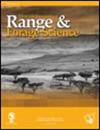Bromatological and histological features of native African grasses under grazing in Brazilian semi-arid rangelands
IF 1.9
4区 环境科学与生态学
Q3 ECOLOGY
引用次数: 1
Abstract
This study evaluated the bromatological and histological features of native African grasses under grazing in Brazilian semi-arid rangelands. An experimental grid design was used in a randomised sampling method for four replicate samples of three African grasses. The grasses evaluated were: Cenchrus ciliaris L., Digitaria pentzii Stent. and Megathyrsus maximus (Jacq.). The bromatological and histological traits analysed included dry matter (DM), crude protein (CP), neutral detergent fibre corrected to ashes and protein (NDFap), lignin, mesophyll, vascular bundle, phloem, xylem, vascular sheath, sclerenchyma, bulliform cells, and the adaxial and abaxial epidermis. The type of grass and grazing cycle correlated with DM, NDF and lignin (p < 0.05), whereas CP was not affected by these factors (p > 0.05). Dry matter ranged between 128 and 304 g kg−1; CP ranged between 90 and 167 g kg−1; NDFap between 542 and 707 g kg−1, and lignin between 10 and 40 g kg−1. The proportion of xylem (8.4%), vascular sheath (30.5%) and total vascular bundles (38.1%) were greater in M. maximus (p < 0.05). The percentage of sclerenchyma did not differ between species (p > 0.05). Digitaria pentzii and C. ciliaris had a greater proportion of mesophyll than M. maximus (p < 0.05). Of the three grasses analysed. Digitaria pentzii exhibited the highest forage quality, because it had the lowest concentration of fibre and lignin, with lower proportions of lignified tissues.巴西半干旱草原放牧条件下非洲原生禾本科植物的色素学和组织学特征
本研究评价了在巴西半干旱草原放牧条件下非洲原生禾本科植物的色谱和组织学特征。实验网格设计用于随机抽样方法,对三种非洲草的四个重复样本进行了研究。评价的禾草有:毛蕊草、五角马。和巨蟒(Jacq.)。对其干物质(DM)、粗蛋白质(CP)、中性洗涤纤维(NDFap)、木质素、叶肉、维管束、韧皮部、木质部、维管鞘、厚壁组织、球状细胞、近、背面表皮等性状进行了分析。牧草类型和放牧周期与DM、NDF和木质素相关(p < 0.05),而CP不受这些因素的影响(p > 0.05)。干物质在128 ~ 304 g kg - 1之间;CP范围在90 ~ 167 g kg - 1之间;NDFap在542 ~ 707 g kg - 1之间,木质素在10 ~ 40 g kg - 1之间。木质部比例(8.4%)、维管鞘比例(30.5%)和总维管束比例(38.1%)均高于粗木质部(p < 0.05)。不同种属间厚壁组织百分率无显著差异(p > 0.05)。五子黄和毛缕黄牛的叶肉比例高于大黄(p < 0.05)。三种草的分析。五子柳的纤维和木质素含量最低,木质化组织比例较低,饲草质量最高。
本文章由计算机程序翻译,如有差异,请以英文原文为准。
求助全文
约1分钟内获得全文
求助全文
来源期刊

African Journal of Range & Forage Science
ECOLOGY-ENVIRONMENTAL SCIENCES
CiteScore
4.00
自引率
14.30%
发文量
35
审稿时长
>12 weeks
期刊介绍:
The African Journal of Range & Forage Science is the leading rangeland and pastoral journal in Africa. The Journal is dedicated to publishing quality original material that advances rangeland ecology and pasture management. The journal aims to publish research of international importance from any region, but as an African journal, we are particularly interested in research from Africa and relevant to the continent. The Journal promotes both science and its application and authors are encouraged to explicitly identify the practical implications of their work. Peer-reviewed research papers and research notes deal primarily with all aspects of rangeland and pasture ecology and management, including the ecophysiology and biogeochemistry of rangelands and pastures, terrestrial plant–herbivore interactions (both domestic and wild), rangeland assessment and monitoring, effects of climate change on rangelands, rangeland and pasture management, rangeland rehabilitation, ecosystem services in support of production, conservation and biodiversity goals, and the identification and development of intensive and semi-intensive pasture and forage resources to meet livestock production needs. Articles highlighting transdisciplinary linkages among biophysical and social sciences that support management, policy and societal values are particularly encouraged. The Journal includes relevant book reviews and invited perspectives that contribute to the development of range and forage science. Letters to the editor that debate issues raised in the Journal are acceptable. The African Journal of Range & Forage Science is the official journal of the Grassland Society of Southern Africa.
 求助内容:
求助内容: 应助结果提醒方式:
应助结果提醒方式:


